Does it matter where you place your Tree Swallow boxes?
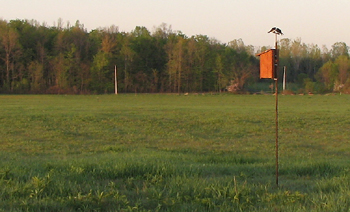
- It certainly does! Placing Tree Swallow boxes correctly is a matter of life or death for the birds.
- It’s a sad fact that many people trying to “help wildlife” are themselves responsible for deaths of birds by unwittingly placing nest boxes in poor places.
- Unfortunately, chronic shortage of suitable nest sites forces Tree Swallows to attempt to nest in dangerous situations.
- Make it your goal to try to avoid mortality of your birds by putting boxes where predation and competition from other cavity-nesting species won’t happen.
- Luckily, there are some simple box placement guidelines for Tree Swallows. Following them will maximize the safety and nesting success of your birds. Ignoring them adds risks that your birds will be killed or their nests will fail.
- Remember, the guidelines below are for Tree Swallows only! They aren’t meant for Bluebirds, Purple Martins, or any other cavity nesters, which all have their own, different sets of guidelines.
GUIDELINES FOR SAFE PLACING OF TREE SWALLOW BOXES:
- Place boxes on poles well out in open areas whenever you can.
- Space boxes about 100 feet or 30 meters apart.
- Keep boxes at least 50 yards or meters away from water edges.
- Place boxes at least 100 yards or meters away from buildings.
- Keep boxes at least 50 yards or meters from trees, bushes, fences, and ditches.
- Locate boxes at least 25 yards or meters from roads and trails.
- Once you understand the fundamentals of box placement for Tree Swallows try evaluating nest box situations you see as you travel around. You’ll be appalled at how many boxes you encounter are death traps.
- And, by the way, don’t ever assume box placements at nature centers or wildlife refuges are correct. Unfortunately, very often they are not.
- Below are explanations for the above Tree Swallow box location guidelines.
Never place a Tree Swallow box right next to a body of water! Keep boxes at least 50 YARDS from bodies of water if you can.
- Reason: To reduce the chances raccoons will find them. Raccoons are deadly nest predators that often hunt along edges of lakes, ponds, rivers and streams.
- Many bird books state Tree Swallows like to nest “near water,” which is true, but this does not mean you should place boxes at water’s edge. Remember, to a swallow water within a mile is “nearby.”
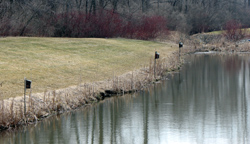
Keep boxes at least 100 YARDS or METERS, from houses and barns.
- Reason: To avoid House Sparrows (below), which are deadly enemies of Tree Swallows and many other of our native cavity-nesting birds.
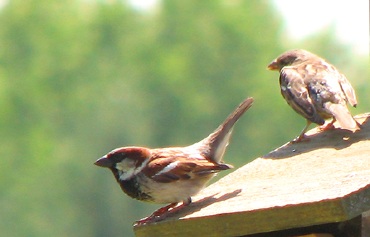
- For example, in the photo below Monty Martin of Indiana holds the bloody remains of two Tree Swallows bludgeoned to death in their boxes by House Sparrows.
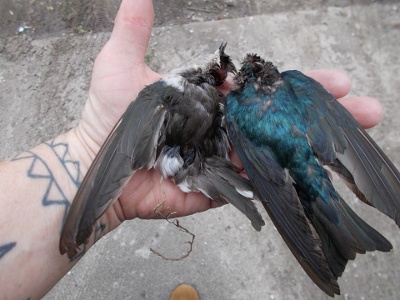
- For more on the House Sparrow problem see House Sparrow damage to Tree Swallow Nestings.
Keep boxes at least 50 YARDS or METERS away from trees and bushes.
- Reason: To avoid House Wrens (below), which prefer dense woody plant cover.
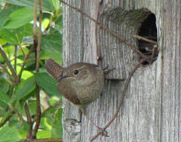
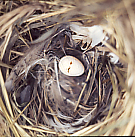
- Wrens can be very destructive, and will take over swallow boxes, puncture swallow eggs (above), throw out eggs and small young, and fill the box with the small sticks which form much of wren nests.
- Remove all shrubs near boxes, or better yet don’t put a box meant for swallows near shrubs or trees.
- For more on this problem see Reducing House Wren damage to Tree Swallow Nestings.
Keep boxes at least 50 YARDS or METERS away from wood edges, hedgerows, fences, and ditches.
- Reason: Predators like raccoons and opossums move along these landscape features as they travel and hunt.
- Also, bird-hunting hawks and falcons can approach using hedgerows and wood edges as screens.
- For example, the boxes below are at the edge of taller vegetation along which predators are apt to travel. These boxes are also placed way too close to one another.
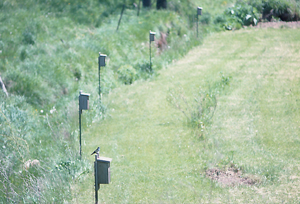
Never place a Tree Swallow nest box on a tree!
- Reason: They are way too easy for predators like raccoons to reach, or for squirrels to takeover for their own use.
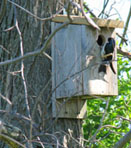
- Note the squirrel-enlarged hole in a this tree-mounted box. Squirrels and also chipmunks prey on many cavity-nesting birds.
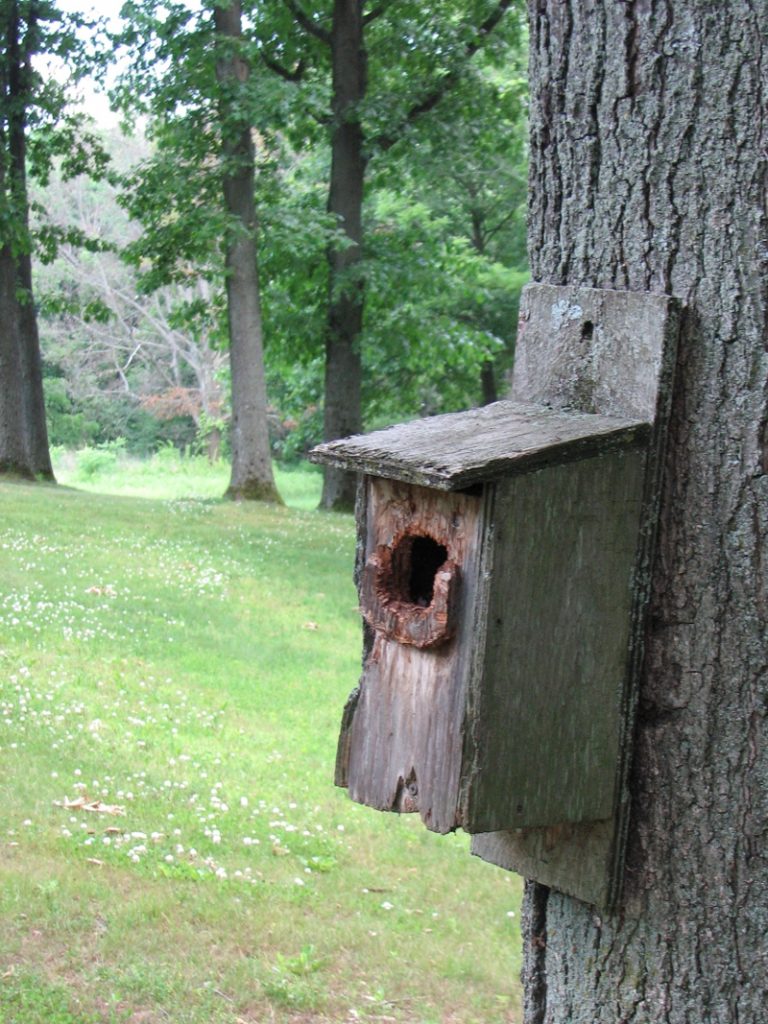
Keep boxes at least 25 YARDS or METERS away from roads and trails where people can approach easily.
- Reason: To avoid vandalism or excess human disturbance that could cause nesting swallows to desert. The boxes below are too close to a road.
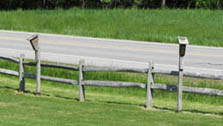
To summarize: Placing Tree Swallow boxes well away from buildings, trees and shrubs, roads, and water edges will reduce dangers to the birds and their nests.
How far apart should Tree Swallow nest boxes be spaced?
- Tree Swallow boxes should be 100 feet or 30 meters apart, or more if possible.
- Tree Swallows are more territorial than many other swallow species.
- Experiments have shown Tree Swallow pairs usually nest as far as possible from other pairs if given a choice.
- It’s true Tree Swallows will sometimes nest closer, but squabbling between crowded pairs can interfere with care of eggs and young and reduce nesting success.
- Measure your stride so you can use number of steps as a simple way to determine approximate proper distance between boxes in the field.
- Arranging boxes in a grid or loop makes it convenient for making box checks.

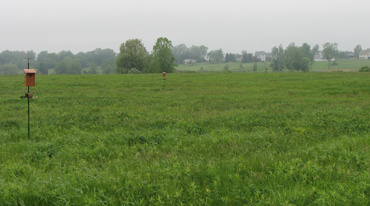
- Attention: See the Mounting Boxes on Poles page for additional information including proper height for boxes on poles and direction for facing boxes.
Next Step: Pole Options for Nest Boxes
—————————————————————————–
Home: Tree Swallow Nest Box Projects
Creating Tree Swallow Nest Box Projects
Spring Return
Nesting Season Behavior
Song and Calls
Nest Site Claiming
Pair Formation
Nest Building
Bird Flight
Mating and Paternity
Diary of One Season at Salmon Creek
Monitoring Nest Boxes and Keeping Records
Making Box Checks Keeping Box Records Control Sheets Season Summaries Print Sheets
Banding Your Tree Swallows Banding Adults Banding Nestlings
Tree Swallows in Research Research Bibliography Glossary of Terms